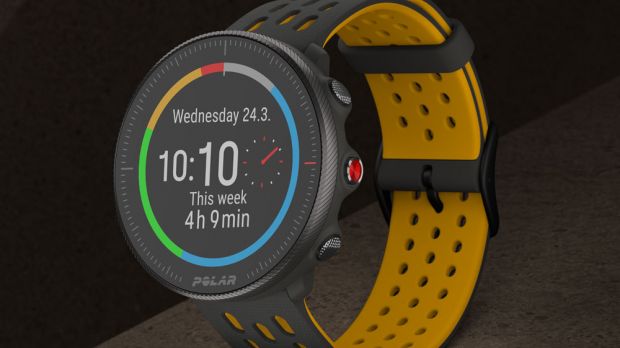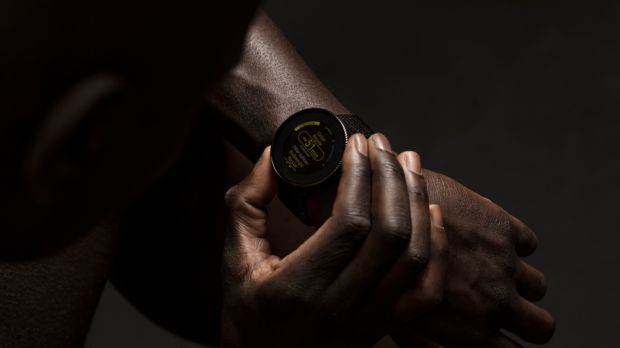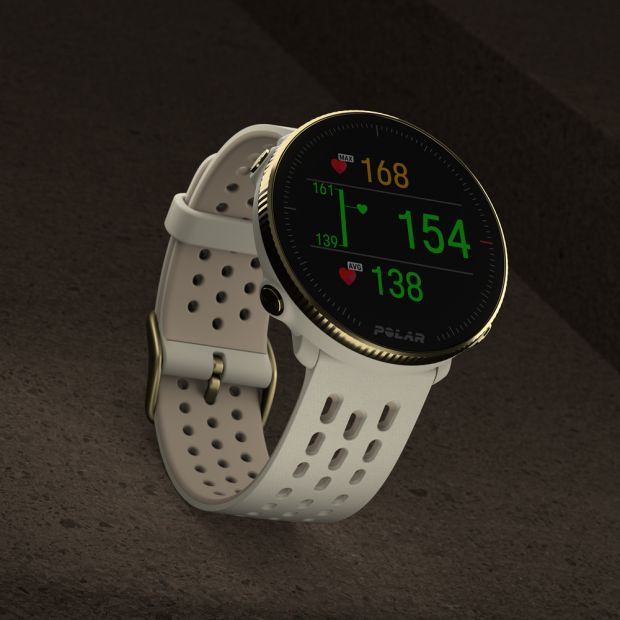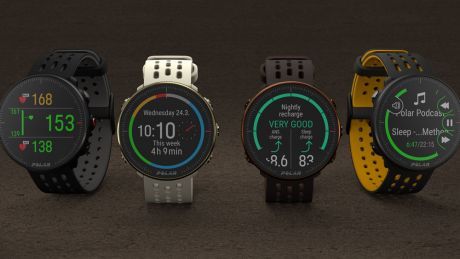Our Verdict
The Polar Vantage M2 has a well-rounded set of sports tracking features, plus the notable extra of Fuelwise, which can help you fuel correctly for longer runs and rides. You can get more features from similarly priced Garmin and Coros watches, but the M2 holds its own in the mid-range bracket.
For
- Multisport mode
- Fuelwise nutrition coach
- Useful training analysis
Against
- No breadcrumb navigation
- No music storage
You can trust Coach
There’s stiff competition for the hearts and minds of amateur endurance athletes who want a device that offers more than a beginner GPS watch but don’t want to splash out £400-plus on a high-end watch. With the new Vantage M2, priced at £269, Polar aims to offer a genuine rival to the Garmin Forerunner 245 and Coros Apex.
The M2 is a multisport watch that tracks pretty much every sport going, including triathlon and open-water swimming, along with heart rate monitoring, training load analysis and Polar’s impressive sleep tracking and daily workout suggestions.
The most exciting new feature to arrive on the watch is Fuelwise. It’s present on Polar’s high-end devices, the Vantage V2 and Grit X, and we named it our favourite new feature of 2020 in the Coach Fitness Tracker Awards. With Fuelwise you can set up a nutrition plan for training sessions that last longer than 90 minutes and get reminders when to consume carbohydrates. These reminders will be adjusted to how hard you’re working, based on your heart rate, so you refuel when you actually need it.
Fuelwise also gives you a breakdown of the fuel used in each workout, based on percentage of calories from carbs, protein and fat. When working in higher heart rate zones you’ll be using mostly carbs, whereas fat is your primary source of fuel when exercising at a lower intensity. Each week you also get a breakdown of the nutrients you used during training.
This is particularly useful for calculating your nutrition needs on longer runs and cycles, matching it more closely to what your body really requires. While the feature is most useful for ultramarathon runners, Ironman triathletes and long-distance cyclists, it could be invaluable for marathon runners as well. It’s a feature that sets Polar devices apart – there’s no equivalent offered by other brands – so it’s great to see it on the mid-range M2.
Along with Fuelwise, other features that have trickled down to the M2 from Polar’s more expensive watches include weather forecasts and music controls. There’s also watch face customisation, including the useful training load watch face (pictured, below), which breaks down your weekly training into heart rate zones. This lets you see at a glance if you have achieved a well-balanced range of sessions – too much time spent in the higher yellow and red zones and not enough in the easy blue and green is a recipe for burn-out or injury.

The Vantage M2 also has customisable workouts and although it doesn’t have breadcrumb navigation, a feature you do get on the Forerunner 245 and Coros Apex, it offers a back-to-start pointer during activities so you can at least head in the direction of home if you get lost on a run or cycle.
I’ve used the M2 to track a range of workouts and it’s mostly performed well. The accuracy of the GPS when tracking outdoor running and cycling passes muster when tested against other watches and on a wheel-measured loop. The M2, like Polar’s other watches, tends to be slightly generous on distance covered, and the pace reading will jump around if you take a sharp turn while running, but overall its performance was in line with other watches.
The heart rate monitoring, however, was nowhere near accurate enough to be useful. I didn’t have one run where the M2 tracked my heart rate accurately when compared with the reading from a Garmin HRM-Pro chest strap. The M2 kept picking up phantom spikes in my heart rate, and around those spikes it would read too low for long stretches. When doing other types of exercise, like strength workouts and indoor cycling sessions, it was better, but even then it would lag behind spikes in my heart rate or miss them completely when compared with the chest strap.
This is to be expected on watches with optical heart rate sensors, which always struggle to track accurately, and I’ve always had problems with Polar devices. It can be resolved by purchasing a chest strap and pairing it with the M2. It’s well worth budgeting for this extra expense to get the most from the M2, because that heart rate information is crucial to Fuelwise and the training load analysis. These are the two features that set the M2 apart in its price bracket.
The cardio load analysis on the M2 gives an overall rating of your training, telling you whether it’s productive, or if you’re overreaching, maintaining your fitness or de-training owing to a lack of activity. You also get a strain score to see how much stress you’re placing on your body, and a tolerance score that estimates what you can handle. Over time you want to see that tolerance rise, and to balance the amount of strain you place on yourself against it.

There’s help from the M2 on this front in the form of suggested workouts each day. These use Polar’s impressive sleep analysis to take into account your recovery overnight. I found that the sleep tracking wasn’t of the standard of the Oura ring, which is the most accurate device I’ve come across for sleep tracking, and the M2 sometimes failed to log my sleep at all or overestimated my time asleep, tending to extend it too far in the morning.
However, when it did log my sleep, the M2 was accurate enough to make its sleep analysis and subsequent recommendations worth considering. After a poor night’s sleep you’ll generally be advised to scale back your exercise, and on days when you’re well rested you’ll get harder workout recommendations.
Most of this is displayed on the watch with at-a-glance ratings and advice, but more detail on your sleep and cardio load is in the Polar Flow app. This app has become more user-friendly of late and while it still takes a few days to get used to it and understand where everything is, it generally provides a good experience. There are a few features that are still only available on the Polar Flow website, like extra detail on your workouts or setting up a particularly complicated structured training session to follow, but the app provides a more complete experience than it has in the past.
The M2 offers 40 hours of GPS battery life, which is impressive, but like other Polar models it seems to drain faster when not training than watches from Garmin and Coros do. During a one-hour run it dropped by only two percentage points, but it drained at a rate of more than ten points a day outside of my training. The battery level also has a habit of dropping in fits and starts, going hours without changing much then suddenly losing 5% – far from ideal if you’re trying to judge how much more use you can get out of it before charging it. After several battery cycles the M2 is consistently lasting five to seven days on a charge, and if you’re not running outside every day you’ll get seven reliably.
See related
- The Best Fitness Trackers Of 2021
- The Best Running Watches Of 2021
- The Best Heart Rate Monitors Of 2021

The M2 isn’t an attractive watch in my opinion, especially compared with a smartwatch, but the second generation comes in a greater range of colours including the gold champagne option I’m using. There are also leather (£44.50), woven (£36) and solid silicone (£26.50) straps so you can swap out the sporty perforated silicone strap the M2 ships with.
The M2 is a very strong addition to the mid-range bracket of sports watches. The Garmin Forerunner 245 offers breadcrumb navigation and (on the £300 version of the watch) music, either your own or Spotify or Amazon Music services; the Coros Apex offers superior battery life as well as breadcrumb navigation. There is also the excellent Coros Pace 2 for £180, which is a tremendous tracker with a beefy battery life.
The M2 stands out from its competition thanks to the Fuelwise feature and the more in-depth recovery and training analysis, along with multisport and open-water swimming tracking, which the Forerunner 245 lacks.
I think the Garmin offers a slightly better user experience: I prefer its look and feel on the wrist, and the buttons are more responsive. However, the Vantage M2 is just as good in all the key tracking areas, and if you’d rather have Fuelwise than breadcrumb navigation, it’s the device for you.
Buy from Polar | £269

Nick Harris-Fry is a journalist who has been covering health and fitness since 2015. Nick is an avid runner, covering 70-110km a week, which gives him ample opportunity to test a wide range of running shoes and running gear. He is also the chief tester for fitness trackers and running watches, treadmills and exercise bikes, and workout headphones.

